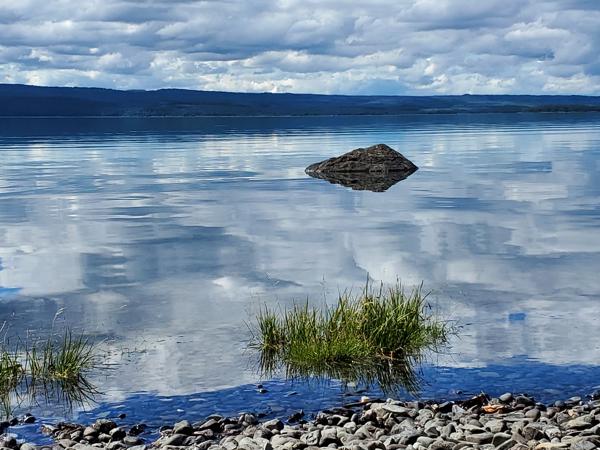How Stormwater is Regulated
On This Page:

What is stormwater?
When rainfall or snowmelt occurs, several things happen to the precipitation. Some of the precipitation infiltrates into the soil surface, some is taken up by plants, and some is evaporated into the atmosphere. Stormwater is what is left over that does not immediately soak into the ground. Stormwater runs off of the land and hard surfaces such as streets, parking lots, and rooftops. As it flows across the land surface it may pick up pollutants such as fertilizers, sediment, pesticides, or oil and grease.
Why be concerned about stormwater pollution?
Stormwater runoff can have a number of impacts. As development and the amount of hard surfaces increase in a basin or watershed the natural capacity of the soil and vegetation to infiltrate and take up rainfall or snowmelt decreases, and more rainfall and snowmelt becomes stormwater runoff. This can produce negative impacts by causing erosion of land areas and stream banks by causing or increasing flooding and also carrying pollutants to streams or wetlands.
Types of pollutants commonly found in stormwater runoff
The Table below summarizes common stormwater pollutants and also provides information on potential sources of these pollutants and types of impacts they may cause.
| Sediment |
|
| Nutrients |
|
| Organic Matter |
|
| Bacteria |
|
| Oil and Grease |
|
| Toxic Substances |
|
| Heavy Metals |
|
| Temperature |
|
Types of activities that citizens can do to help control stormwater pollution
Many of our daily activities have the potential to cause stormwater pollution. Any situation where activities can contribute more pollutants to stormwater runoff is an area that should be considered in attempts to minimize impacts. The list below is certainly not all inclusive, but it gives an idea of things citizens can do to help control stormwater pollution.
- Maintain buffer areas around stream segments to protect stream banks and to provide a mechanism for pollutant removal.
- Minimize impervious areas to reduce runoff.
- Design all new construction to prevent or minimize runoff and stormwater pollution – a major component here is planning up front in the design process to consider and manage potential stormwater problems.
- Practice "good housekeeping" by keeping areas clean of potentially harmful pollutants. This also may involve changing activities or practices if they have potential impacts.
- Use lawn care practices that protect water quality – minimize the use of fertilizers and pesticides, and when used, do so in a safe manner. When possible incorporate native plant species since they are best adapted to the local growing conditions and tend to be naturally pest resistant.
- Properly use and store household materials and be aware of and make use of local recycling and collection centers to handle household wastes.
- Remember that any materials that are poured or placed on the ground, streets, driveways, etc. can be picked up and carried by stormwater runoff to our surface waters
- Report any pollution, illegal dumping, or soil erosion that you see to the appropriate authorities.
- Get involved with local efforts for public education, water quality monitoring, stream cleanup, recycling, etc.
Who must apply for a stormwater discharge permit?
There are three general classes of activities that must be covered by stormwater permits. These are:
- Construction activity that disturbs one or more acres or which is part of a larger project that disturbs one or more acres in total.
- Several types of industrial or commercial activity.
- Many city storm sewer systems in larger communities or those near larger communities.
Construction activity that disturbs one or more acres must be covered by a stormwater permit before any soil is disturbed at the site. The permit coverage must be continued until all building is completed and the ground is completely stabilized with a permanent, perennial, vegetative cover. For residential and commercial developments, permit coverage must be maintained after initial grading and street construction. Building is not complete until all houses and buildings are constructed and the ground has been stabilized. Before this is achieved, permit coverage must be maintained.
Industrial and commercial activities that are classified as having "stormwater discharge associated with industrial activity" are required to obtain permit coverage. As found in the Code of Federal Regulations, 40 CFR 122.26. Most industrial activities are covered under the Multi-Sector General Permit. Facilities such as asphalt plants, concrete batch plants, quarries, sand and gravel pits and rock crushers are covered under Multi-Sector General Permit. If all industrial materials and activities are protected by a storm resistant shelter to prevent exposure to rain, snow, snowmelt, and/or runoff you may not need a stormwater permit. Industrial materials or activities include, but are not limited to, material handling equipment or activities, industrial machinery, raw materials, intermediate products, by-products, final products, or waste products. Material handling activities include the storage, loading and unloading, transportation, or conveyance of any raw material, intermediate product, final product or waste product.
The Municipality of Anchorage, Port of Anchorage, City of Fairbanks, City of North Pole, Fairbanks North Star Borough, and the University of Alaska Fairbanks are required to have permits for their Municipal Separate Storm Sewer Systems (MS4s). The determination of which cities and universities are required to obtain MS4 permits involves a combination of population, proximity to large, urbanized areas and water quality of receiving streams. These permits require municipalities to implement measures to reduce pollutants in stormwater from illicit discharges and construction sites, to provide public education and allow public participation, to minimize pollutants from municipal operations and to address post-construction runoff.

 Indicates an external site.
Indicates an external site.